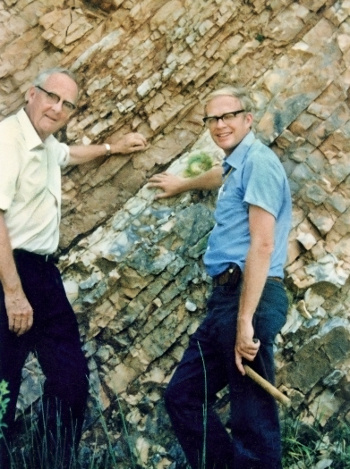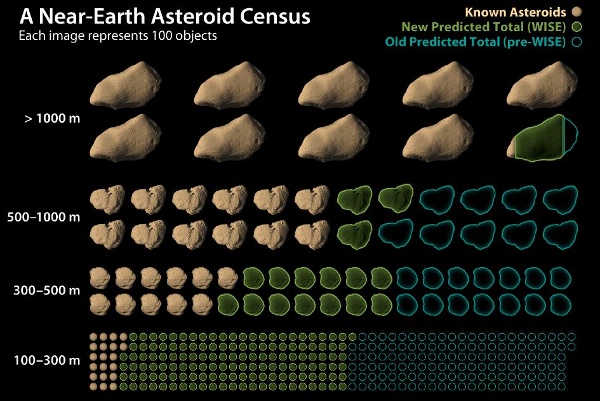Near Earth Asteroids
October 5, 2011
Frank Asaro, presently an
Emeritus Senior Scientist at
Lawrence Berkeley National Laboratory, wrote about the
physicist,
Luis Avlarez, and his
planetary scientist son,
Walter Alvarez, in 1987. The father-son team had come to his office looking for help in the analysis of some
clay samples.
"In early October, 1977, Luis W. Alvarez and his son Walter dropped into my office at the Lawrence Berkeley Laboratory (LBL)... There was no funding for these measurements, so we had to squeeze them in with our other work."
Scientists are forced to do this all the time. Their ideas develop more rapidly than their funding sources. At the time of this meeting, their quest was in the realm of "
normal science." They intended to measure the time it took to deposit the clay layer by measuring the concentration of the element,
iridium. Iridium is not a major component of
Earth's crust, but the Earth does obtain iridium at a steady rate from the infall of
micrometeorites from
space.
The estimated rate is considerable, about ten million
kilograms of iridium per year, but it's distributed uniformly on Earth's surface, so the concentration in any one place is very small. The Alvarez duo approached Asaro, since his lab could do a very sensitive trace element analysis called
neutron activation. By measuring the iridium, they would be measuring the duration of time.

Luiz Alvarez (left) and his son, Walter.
(Lawrence Berkeley Laboratory photograph, via Wikipedia))
The clay layer marked a strange period in
geologic time called the
Cretaceous-
Tertiary (K-T) boundary when 75% of
species became
extinct, including the (non-
avian)
dinosaurs. Asaro had little hope for the
experiment, since he never detected iridium in any other specimens, including
archaeological specimens made from clay.
Instead, he found an iridium concentration in the clay sample that was at least a hundred times greater than expected. To quote Asaro's reaction to a confirmatory experiment, "...the two iridium
gamma-ray peaks looked like mountains!"
Eventually, a theory developed that an asteroid, 10
kilometers (6
miles) in diameter, had hit the Earth, causing such an environmental catastrophe that most species became extinct. The
Chicxulub crater, centered on
Chicxulub, Yucatán,
Mexico, is considered to the the vestige of that impact.
The transition from the Cretaceous to the Tertiary period happened about 65 million years ago, which seems like a long time back; but it's actually quite recent considering Earth's
4.5 billion year history. With that thought in mind, we wonder whether such a thing might happen again. Even the
US Congress, which is hard to impress, allocated funding to
NASA in 1992 for a ten year program to find 90% of large near-Earth
asteroids that may become meteoric threats to Earth. The project is called
Spaceguard.[4]
To accomplish the goal, NASA launched its
Wide-field Infrared Survey Explorer satellite, or WISE, on December 14, 2009.[3-9] The WISE satellite contains a
space telescope that's quite a bit smaller than the
Hubble Space Telescope and the proposed
James Webb Space Telescope. You could carry this telescope, called NEOWISE (Near-Earth Orbit Wide-field Infrared Survey Explorer), in your arms, but it was sensitive enough to do its intended mission. NEOWISE did an
infrared scan of the entire sky, twice, from January, 2010, to February, 2011.[4]
The previous estimate of dinosaur-extinguishing asteroids was about 1,000. WISE found 981, and NASA is certain that it's discovered them all.[4] It's also certain that it's discovered at least 90% of asteroids one kilometer in size, or larger.[4] Said
Amy Mainzer, NEOWISE principal investigator at NASA's
Jet Propulsion Laboratory,
"By virtue of the fact that we know these objects, and we know their orbits, we can predict that they are no longer hazardous to Earth in the sense that we can follow them, and we know that there are none that pose any imminent risk of an impact."[4]
"As one of my colleagues at the Jet Propulsion Laboratory likes to say, the best three ways of dealing with the potential of an asteroid impact are to find them early, find them early and find them early."[5]
The orbital data indicate that none of the large asteroids would collide with Earth in the next few centuries.[3-8] After the population of large asteroids, there exists about 20,000 100 meter near-Earth asteroids that could destroy a city. NASA is tracking more than 5,000 of these, but it expects that it needs to discover an additional 15,000 to have their full complement (see figure).[4] NASA has the additional mandate from the US Congress to find ninety percent of asteroids larger than about 450 feet in size by 2020.[5]

Asteroid census data from the NASA WISE mission. Each image represents 100 objects in the population of near-Earth asteroids. The blue outlines show the estimated numbers before the NEOWISE survey. The shaded objects show NASA's revised, lower estimate.(Image: NASA/JPL-Caltech).
Lurking in the background are more than a million smaller near-Earth asteroids that would still survive their plunge through Earth's atmosphere and inflict ground damage, although on a smaller scale.[3]
WISE data also
falsified a theory of the origin of the dinosaur-annihilating asteroid. This theory was proposed in 2007 on the basis of ground-based telescope data of the remnant of the large asteroid,
Baptistina. The theory proposed that Baptistina crashed into another asteroid about 160 million years ago, and a large fragment from the impact found its way to Earth.[9].
WISE measured 1,056 members of the
Baptistina family and determined that the break-up occurred just 80 million years ago, only half as far back as the original estimate. This estimate was based on the time it would take for the fragments to reach their present positions. This would give a Baptistina fragment just 15 million years to reach Earth, which is not possible considering that the mechanism would need to have been the
gravitational influences of
Jupiter and
Saturn.[9]
References:
- Frank Asaro, "The Cretaceous-Tertiary Iridium Anomaly and the Asteroid Impact Theory," Chapter 21 of Discovering Alvarez:
selected works of Luis W. Alvarez, with commentary by his students and colleagues, University of Chicago Press, 1987, 272 pages (via Google Books); also available from Amazon.
- Luis W. Alvarez, "Experimental evidence that an asteroid impact led to the extinction of many species 65 million years ago," Proc. Natl. Acad. Sci., vol. 80, no. 2 (January 15, 1983), pp. 627-642; also available as a PDF file, here.
- Whitney Clavin and Dwayne Brown, "NASA Space Telescope Finds Fewer Asteroids Near Earth," NASA Press Release No. 2011-304, September 29, 2011.
- Suzanne Presto, "NASA's Asteroid Hunter Finds Fewer 'Planet-Buster' Asteroids Than Predicted," Voice of America News, September 29, 2011.
- Nell Greenfieldboyce, "Asteroids Pose Less Risk To Earth Than Thought," NPR, September 30, 2011.
- Rik Myslewski, "NASA: 'Asteroid armageddon less likely than we feared'," The Register (UK), September 30, 2011.
- Alex Knapp, "There May Be Fewer Dangerous Asteroids Than Previously Thought," Forbes Blogs, September 30, 2011.
- NASA Wise Mission Web Site.
- Whitney Clavin and Trent J. Perrott," Origin of Dinosaur-Killing Asteroid Remains a Mystery," NASA Press Release No. 2011-296, September 19, 2011.
Permanent Link to this article
Linked Keywords: Frank Asaro; Emeritus; Senior Scientist; Lawrence Berkeley National Laboratory; physicist; Luis Avlarez; planetary scientist; Walter Alvarez; clay; normal science; iridium; Earth; crust; micrometeorite; outer space; kilogram; neutron activation; Wikipedia; geologic time; Cretaceous; Tertiary; species; extinct; avian; dinosaur; experiment; archaeological; gamma-ray; kilometer; mile; Chicxulub crater; Chicxulub, Yucatán; Mexico; age of the Earth; 4.5 billion year history; US Congress; NASA; asteroid; Spaceguard; Wide-field Infrared Survey Explorer satellite; space telescope; Hubble Space Telescope; James Webb Space Telescope; infrared; Amy Mainzer; Jet Propulsion Laboratory; falsifiability; Baptistina; Baptistina family; gravity assist; Jupiter; Saturn.